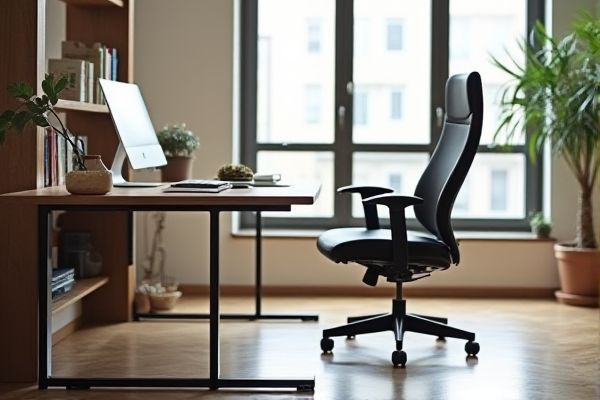
Task chairs provide adjustable support with armrests, backrests, and height options designed for prolonged desk work, while ergonomic stools encourage active sitting by promoting better posture and core engagement without full back support. Discover which seating option best suits Your workspace needs by exploring the detailed benefits and considerations ahead.
Table of Comparison
| Feature | Task Chair | Ergonomic Stool |
|---|---|---|
| Design | Upright chair with backrest and armrests | Backless or minimal backrest, often with foot ring |
| Posture Support | Supports lumbar region, encourages proper sitting posture | Promotes active sitting, strengthens core muscles |
| Adjustability | Height, tilt, armrests adjustable | Height adjustable, limited tilt options |
| Use Case | Office work, prolonged sitting | Dynamic tasks, short to moderate durations |
| Mobility | Usually has casters for easy movement | Some models have casters or glides |
| Comfort | Cushioned seat and back for extended comfort | Firm seat to encourage active posture |
| Price Range | Moderate to high | Moderate |
Introduction to Task Chairs and Ergonomic Stools
Task chairs feature adjustable height, lumbar support, and swivel capabilities designed for prolonged desk work, promoting comfort and productivity. Ergonomic stools emphasize active sitting by encouraging movement and engaging core muscles through minimal back support and a stable, often saddle-shaped seat. Both seating options aim to improve posture but cater to different user needs and workspace dynamics.
Key Design Differences
Task chairs feature adjustable armrests, lumbar support, and a high backrest to promote proper posture during extended sitting, while ergonomic stools emphasize a minimalistic design with a contoured seat to encourage active sitting and core engagement. The key design difference lies in task chairs providing comprehensive support structures for prolonged desk work, whereas ergonomic stools prioritize mobility and dynamic seating to reduce static postures. Your choice depends on whether you need stability and back support or enhanced movement and posture flexibility during work.
Comfort and Support Comparison
Task chairs typically offer enhanced comfort and support with adjustable features such as lumbar support, armrests, and reclining capabilities, promoting proper posture during extended work hours. Ergonomic stools provide greater mobility and encourage active sitting, which engages core muscles and improves circulation but may lack back support and cushioning found in task chairs. Choosing between the two depends on individual needs for prolonged comfort, support, and dynamic seating options in work environments.
Ergonomics and Posture Benefits
Task chairs provide structured support for the lower back and promote proper spinal alignment, reducing strain during prolonged sitting. Ergonomic stools encourage active sitting by engaging core muscles and promoting dynamic posture changes, which can enhance circulation and reduce pressure on the spine. Both options improve ergonomics, but stools uniquely support natural movement and posture flexibility.
Mobility and Flexibility
Task chairs offer superior mobility with adjustable wheels and swivel capabilities that allow you to move effortlessly around your workspace. Ergonomic stools prioritize flexibility through height adjustability and dynamic seating positions, encouraging active posture changes. Both options enhance productivity by supporting movement, but task chairs provide greater ease of transport across different areas.
Space-Saving and Aesthetic Considerations
An ergonomic stool offers a compact, minimalist design that saves valuable office space and promotes better posture, making it ideal for smaller work areas. Task chairs typically provide more adjustability and cushioning but occupy greater floor space, potentially overwhelming a sleek office setup. Choosing an ergonomic stool for your workspace enhances both functionality and aesthetic appeal while optimizing room layout.
Durability and Material Choices
Task chairs typically feature durable frames made of steel or reinforced plastic, combined with high-quality upholstery like mesh or leather, ensuring long-lasting support and comfort. Ergonomic stools often utilize premium materials such as molded polyurethane seats and aluminum bases designed for frequent movement and extended use without compromising stability. Both seating options prioritize robust construction, but task chairs generally offer greater variety in material choices tailored for heavy office use.
Health Impacts and User Wellness
Choosing between a task chair and an ergonomic stool significantly influences your musculoskeletal health and overall wellness. Task chairs provide lumbar support and adjustable features that reduce spinal strain and promote proper posture during extended sitting periods. Ergonomic stools encourage active sitting, enhancing core strength and circulation, which can alleviate lower back pain and improve long-term spinal health.
Ideal Use Cases for Each Option
Task chairs are ideal for extended desk work requiring adjustable support, such as computer tasks and office productivity, offering features like lumbar support, armrests, and swivel capabilities to enhance comfort and posture. Ergonomic stools suit dynamic, active sitting environments such as collaborative workshops, standing desks, or medical settings where mobility and core engagement are prioritized. Choosing between a task chair and an ergonomic stool depends on Your need for sustained seated comfort versus flexibility and movement during short, task-oriented activities.
Choosing the Right Seating for Your Workspace
Choosing the right seating for your workspace depends on your posture needs and activity level; task chairs offer adjustable support for long hours at a desk, promoting proper back alignment and reducing fatigue. Ergonomic stools encourage active sitting by engaging core muscles and increasing mobility, benefiting those who prefer dynamic movement throughout the day. Assess your work habits and comfort preferences to select furniture that enhances productivity and minimizes strain.
 homyna.com
homyna.com